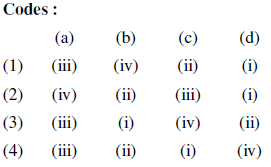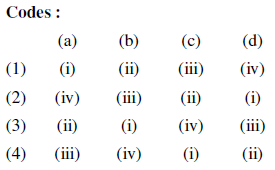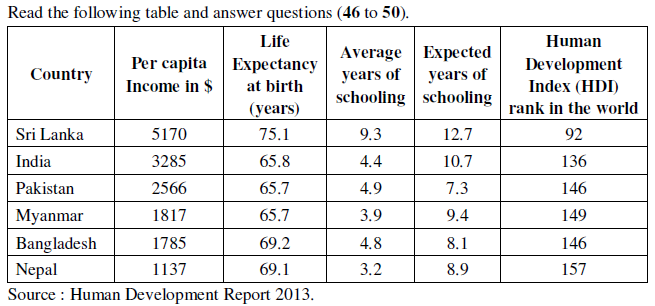POPULATION STUDIES
Paper – II
Note : This paper contains fifty (50) objective type questions of two (2) marks each. All questions are compulsory.
1. Which of the following states is correct to describe level of Total Fertility Rate (TFR) of more than 3.0 (Latest SRS figures 2013)
(1) Bihar and Uttar Pradesh
(2) Bihar, Uttar Pradesh and Rajasthan
(3) Bihar, Uttar Pradesh, Rajasthan and Madhya Pradesh
(4) Bihar, Uttar Pradesh and Madhya Pradesh
2. Match items in List-I with those given in List-II.


3. Arrange the following countries by increasing level of infant mortality rate in the country.
(a) Japan
(b) Sweden
(c) France
(d) United Kingdom
Codes :
(1) Sweden, Japan, United Kingdom, France.
(2) Japan, Sweden, France, United Kingdom.
(3) Japan, Sweden, United Kingdom, France.
(4) Sweden, France, Japan, United Kingdom.
4. The 2011 census of India was carried out in how many districts ?
(1) 610
(2) 620
(3) 630
(4) 640
5. Assertion (A) : The economic impact of improved reproductive health on Women’s lives begins with improvements in their own health in which access to family planning plays a key role.
Research (R) : Access to family planning results in having lesser number of children which in turn encourages women to participate in income generating activities.
Codes :
(1) Both (A) and (R) are true, (R) is the correct explanation of (A).
(2) Both (A) and (R) are true, (R) is not the correct explanation of (A).
(3) (A) is true, (R) is false.
(4) (A) is false, (R) is true.
6. Who among the following worked on cost-benefit analysis of family planning programmes ?
(1) Stephen Enke
(2) C. Chandrasekaran
(3) John Coldwell
(4) John Bongarts
7. Arrange the following Union Territories in descending order (top to bottom) according to the Crude Birth Rate shown in the SRS Bulletin September 2014.
(i) Dadra & Nagar Haveli
(ii) Daman & Diu
(iii) Puducherry
(iv) Lakshdweep
Codes :
(1) (i), (ii), (iii), (iv)
(2) (ii), (iii), (iv), (i)
(3) (iii), (ii), (i), (iv)
(4) (iv), (iii), (ii), (i)
8. According to the SRS Bulletin of September 2014, the infant moralality rate in urban areas of India is :
(1) 24
(2) 25
(3) 26
(4) 27
9. Even after achieving replacement level of fertility, why population continue to grow ?
(1) Due to population ageing
(2) Due to mortality
(3) Due to population momentum
(4) Due to migration
10. According to the census of India-2011, the proportion of population in the age group 15-59 years in urban areas to the total population of India is around;
(1) 60 percent
(2) 62 percent
(3) 64 percent
(4) 67 percent
11. Under the Pradhan Mantri Swasthya Suraksha Yojana (PMSSY), in which combination of cities, new AIIMS like institutions have been established in all the four cities ?
(1) Rishikesh, Raipur, Jodhpur, Jabalpur.
(2) Bhbaneshwar, Rishikesh, Jodhpur, Raipur.
(3) Patna, Bhubaneshwar, Rishikesh, Varanasi.
(4) Patna, Bhubaneshwar, Bhopal, Lucknow.
12. Who among the following proposed ‘Logistic curve of population growth’ in the area of population theories ?
(1) Pearl and Reed
(2) Marx
(3) Engels
(4) Alfred Sauvex
13. Which among the following is not the feature of Rastriya Swasthya Bima Yojana (RSBY)
(1) The hospitalization coverage upto Rs.30,000 per annum.
(2) Transport expenses of Rs.100 per hospitalization.
(3) OPD services may be availed in empanelled hospitals.
(4) The beneficiaries need to pay Rs.30 as registration fee.
14. In which of the following year ‘Target Free Approach’ was adopted in the family welfare programme in India ?
(1) 1996
(2) 2005
(3) 1997
(4) 2002
15. Arrange the following bigger states in descending order (top to bottom) according to crude birth rate as shown in the SRS Bulletin September 2014.
(i) Bihar
(ii) Uttar Pradesh
(iii) Madhya Pradesh
(iv) Jharkhand
Codes :
(1) (i), (ii), (iii), (iv)
(2) (ii), (i), (iii), (iv)
(3) (iii), (iv), (i), (ii)
(4) (iv), (iii), (ii), (i)
16. Assertion (A) : The results based on large surveys and census data related to fertility levels suggest that there is declining trend in the levels of fertility in the country.
Reason (R) : The factors affecting fertility behaviour, of the country’s population in general and eligible couples in the reproductive age group 15-49, in particular are working effectively.
Codes :
(1) Both (A) and (R) are true, and (R) is the correct explanation of (A).
(2) Both (A) and (R) are true, but (R) is not the correct explanation of (A).
(3) (A) is true, (R) is false.
(4) (A) is false, (R) is true.
17. Match items in List-I with the item in List-II given below :


18. Which of the following group of states correctly describe descending level of infant mortality rate (high to low) per SRS, 2014 figures ?
(1) Bihar, Madhya Pradesh, Rajasthan and Uttar Pradesh.
(2) Assam, Madhya Pradesh, Rajasthan, Uttar Pradesh and Odisha.
(3) Bihar, Madhya Pradesh, Odisha, Rajasthan and Uttar Pradesh.
(4) Assam, Odisha and Uttar Pradesh, Chhattisgarh.
19. Among the below listed measures of fertility, which one is the most refined ?
(1) General fertility rate
(2) Total fertility rate
(3) Net reproduction rate
(4) Total marital fertility rate
20. Which of the following expression is used to compute expectation of life at age x ?
(1) ![]()
(2) ![]()
(3) ![]()
(4) ![]()
21. Arrange the following States of India in descending order of exponential rate of population growth in the decade 2001-2011 census of India.
(a) Bihar
(b) Uttar Pradesh
(c) Rajasthan
(d) Madhya Pradesh
Codes :
(1) Bihar, Rajasthan, Madhya Pradesh, Uttar Pradesh.
(2) Uttar Pradesh, Bihar, Madhya Pradesh, Rajasthan.
(3) Bihar, Uttar Pradesh, Rajasthan, Madhya Pradesh.
(4) Uttar Pradesh, Madhya Pradesh, Rajasthan, Bihar.
22. Arrange the following States of India by decreasing order, according to full immunization of children age 12-23 months as per the NFHS-3 Report.
(a) Kerala
(b) Tamil Nadu
(c) West Bengal
(d) Haryana
Codes :
(1) Kerala, Tamil Nadu, West Bengal, Haryana.
(2) Kerala, Tamil Nadu, Haryana, West Bengal.
(3) Tamil Nadu, Kerala, Haryana, West Bengal.
(4) Tamil Nadu, Kerala, West Bengal, Haryana.
23. Which among the following statements describe the status of Jansankhya Sthirta Kosh (Population Stabilization Fund)
(1) One division of Ministry of Health & Family Welfare.
(2) An Independent Autonomous Body.
(3) One division of Department of Family Welfare.
(4) One section of division of Maternal and Child Health in the Ministry of Health & Family Welfare.
24. During which of the following period, India’s family planning programme was declared as family welfare programme :
(1) Mid Sixties
(2) Mid Seventies
(3) Mid Eighties
(4) Mid Fifties
25. Which of the following sequence of countries correctly lists four most population countries in the world according to the U.N. Demographic Year Book ?
(1) China, India, USA, Brazil.
(2) China, India, USA, Indonesia.
(3) China, India, Indonesia, USA.
(4) China, India, Brazil, Indonesia.
26. Identify one of the given category of unorganised workers, which is not covered under the ‘Rashtriya Swasthya Bima Yojana (RSBY) ?
(1) Street Vendor, MNREGA workers, Beedi workers, Truck drivers.
(2) Domestic workers, Steel vendors, Beedi workers, Sanitation workers.
(3) Rag pickers, Auto/Taxi Drivers, Rickshaw pullers, Pottery workers.
(4) Street vendor, Beedi workers, Sanitation workers, Farm labourer.
27. Urbanisation increases in direct proportion with
(1) Zero Population Growth
(2) Crude Birth Rate
(3) Increased non-primary activities
(4) Increased exclusionary zone of urban activity
28. Which among the following is not true about green revolution in the context of high population growth rate during 1961-71 ?
(1) A change from traditional mixed crops to monocrop.
(2) Intensive applications of water, fertiliser and pesticides.
(3) A reduction in the use of hybrid seeds.
(4) Increase in intensity of agriculture by reducing the fallow land.
29. Match the items given below in List-I with the items in List-II.


30. Match items in List-I with those in List-II.


31. Which among the following was not adopted by India to increase food grain supply to its growing population ?
(1) A change from monocropping to multicropping.
(2) Increase use of bio-fertiliser.
(3) Increase use of irrigation.
(4) Increase use of technology.
32. Growth in urban population is observed in which of the following situation ?
(1) Population growth is zero.
(2) Industrialisation is faster.
(3) Growth of construction sector is more.
(4) Land acquisition is faster.
33. Sex ratio in India is defined is
(1) Males per 1000 females
(2) Females per 1000 males
(3) Males per 100 females
(4) Females per 100 males
34. City primacy in the capital town of most of the developing countries is a result of the following :
(1) Preference for large cities for better governance.
(2) Protection of large amount of land for agricultural development.
(3) Financial Crunch to disperse urbanisation.
(4) Past colonial system of development.
35. According to the census of India 2011, which of the following state comes first in population density ?
(1) Kerala
(2) West Bengal
(3) Bihar
(4) Odisha
36. Which among the following is not true about the ‘seeking/available for work information provided by the Census of India 2011 ?
(1) 2011 census for the first time included this information.
(2) Seeking/available for work provides fairly accurate information on unemployment.
(3) Seeking/available for work includes non-worker and marginal workers.
(4) The information is available for both males and females.
37. Which amongst following is not part of urban health care under Draft National health Policy 2015 ?
(1) To cover cities/towns with more than 50,000 population.
(2) Developing sustainable models of partnership with for profit and not for profit sector for health care delivery.
(3) Convergence with various schemes relating to wider determinants of health like drinking water, sanitation, school education, etc.
(4) Capacity building of community based organisations and establishment of appropriate referral mechanism.
38. Which amongst the following are the free entitlements of pregnant women under the Janani Shishu Suraksha Karyakatam (JSSK).
(1) Free and cashless delivery.
(2) Free and cashless delivery and free diagnostics.
(3) Free and cashless delivery, free diagnostics, free diet during stay in hospital.
(4) Free and cashless delivery, free diagnostics, free diet during stay in hospital, free transport from home to health institutions.
39. Who proposed the decade synthetic cohort method for computing age of marriage ?
(1) S.N. Agrawal
(2) J. Hajnal
(3) C. Chandrasekaran
(4) J.R. Rele
40. Assertion (A) : Ninety five percent of the World’s births to adolescents occur in developing countries.
Reason (R) : Early pregnancies among adolescents reflect powerlessness, poverty and pressures from partners, piers, families and communities. And in too many instances, they are the result of sexual violence or coercion.
Codes :
(1) Both (A) and (R) are true, and (R) is the correct explanation of (A).
(2) Both (A) and (R) are true, but (R) is not the correct explanation of (A).
(3) (A) is true, (R) is false.
(4) (A) is false, (R) is true.
41. Which one of the following is true about Polio ?
(1) Water borne disease
(2) Air borne disease
(3) Vector borne disease
(4) Contagious borne disease
42. Neo-classical macro-economic theories of migration emphasizes on which of the following ?
(1) Labour market
(2) Marriage market
(3) Household’s labour portfolio diversification
(4) Individual choice
43. According to census of India 2011 information, which among the following state has the lowest proportion of slum households to urban households ?
(1) Madhya Pradesh
(2) Jharkhand
(3) Gujarat
(4) Kerala
44. Index of ageing is a ratio of which of the following ?
(1) Elderly population in 60 + age group to young population under 15 years.
(2) Elderly population in 60 + age group to population in 15-59 years age.
(3) Young population under 15 years age to elderly population in 60 + age group
(4) Population in 15-59 years age to elderly population in 60 + age group.
45. For estimation of internal migration movement which one among the following is not used ?
(1) Place of birth of the person.
(2) The last or previous place of residence.
(3) Duration of stay of a person at the present place of residence.
(4) Total count in a census and available age-sex distribution of the population.

46. Which of the following countries has lowest human development index ?
(1) Nepal
(2) Myanmar
(3) Pakisthan
(4) India
47. Which country among the following has highest expected years of schooling ?
(1) Pakisthan
(2) Sri Lanka
(3) India
(4) Nepal
48. Which of the following given counties are arranged in ascending order of Life expectancy ? Choose the correct answer.
(1) India, Sri Lanka, Bangladesh, Nepal.
(2) Nepal, Sri Lanka, Bangladesh, India.
(3) Sri Lanka, Bangladesh, Nepal, India.
(4) Bangladesh, Nepal, Sri Lanka, India.
49. Which country among the following has high per capita income in US $ ?
(1) India
(2) Pakisthan
(3) Myanmar
(4) Nepal
50. Which of the following countries are arranged in descending order of average years of schooling ? Choose the correct answer.
(1) Nepal, India, Bangladesh, Pakisthan.
(2) India, Pakisthan, Nepal, Bangladesh.
(3) Pakisthan, Bangladesh, India, Nepal.
(4) Bangladesh, Pakisthan, Nepal, India.
Latest Govt Job & Exam Updates: